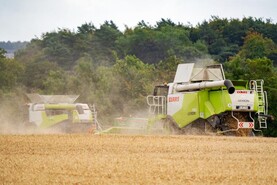Agriculture Minister Edwin Poots ignored the advice of his department officials four times over the past year when making decisions on various schemes, a new report reveals.
DAERA’s annual report and accounts states that the minister gave “ministerial direction” on four separate occasions during the 2020-2021 financial year.
This mechanism is required within government if a minister wants to proceed with a decision which goes against the advice of senior civil servants.
The document states that Minister Poots issued a ministerial direction in late January 2021 which related to a £300,000 support package for fishermen on Lough Neagh.
Minister Poots used ministerial direction to approve the £3.45m aid package for farmers in the northwest who were impacted by flooding in August 2017
On 29 March 2021, two ministerial directions were issued on the same day. The first related to a COVID-19 disruption payment for CAFRE students which cost around £100,000. The second direction was for DAERA to proceed with the £1.3m coronavirus package for wool producers.
Two days later, on 31 March 2021, Minister Poots used ministerial direction to approve the £3.45m aid package for farmers in the northwest who were impacted by flooding in August 2017.
The DAERA report confirms that all four ministerial directions from Minister Poots were approved by Finance Minister Conor Murphy.
Risks
The document also sets out ten “key strategic risks” that the department faced at the start of the 2021-2022 financial year. The highest ranked risk was failure for DAERA to meet its obligations under the NI protocol.
Writing in the report, DAERA permanent secretary Dr Denis McMahon states there are “ongoing challenges” with implementing the protocol.
Other key risks within DAERA relate to keeping food on supermarket shelves amid challenges with COVID-19 and Brexit, a funding or staff shortage within the department, and various issues relating to the environment.
The only key risk within DAERA which relates directly to farming is ranked nine out of ten and surrounds the threat of a disease outbreak in livestock.






 This is a subscriber-only article
This is a subscriber-only article









SHARING OPTIONS: